BENJAMIN GROSSER
PEOPLEText: Memi Mizukami
Now, the street is full of technology. We are surprised everyday to a new technology. But sometime we wondering what the technology will be? Benjamin Grosser is an artist and composer working in USA. He search for something interesting and inexperienced things everyday and then creates amazing works. He completed of the work which have limitless possibilities “Interactive Robotic Painting Machine”. We interviewed him to see his mind.
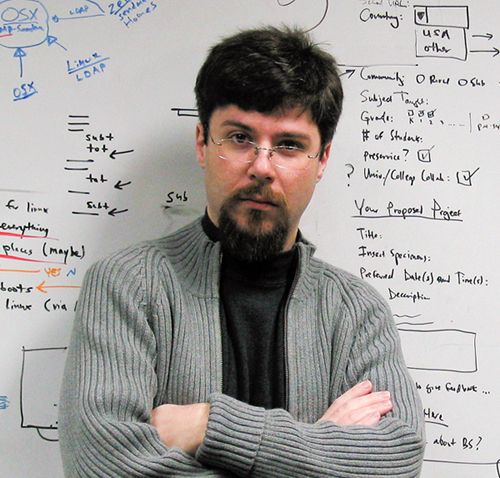
Please introduce yourself.
I am an artist and a composer, currently working on a Master of Fine Arts (MFA) degree in New Media at the University of Illinois at Urbana-Champaign, USA. Prior to this, I completed two degrees in music composition from the same university before moving to the Beckman Institute for Advanced Science and Technology, where I directed the Imaging Technology Group.
We are interested in what you think about on a daily basis. Where does the inspiration come from?
I am fascinated by the ways that technology is changing our experience of the world. Whenever I use these technologies I am constantly analyzing them in terms of their cultural, social, and physiological effects. For example, when I examine how computers display images, I find myself asking whether computer-mediated vision changes how we see without computers? When I watch reality TV shows, I notice how the pace of cuts in their editing is ever increasing, leading me to wonder if “reality” media is altering non-mediated reality? And when I use web services like Google or Facebook that increasingly try to figure out what they think I want, I end up asking myself if artificially-intelligent systems designed to help us instead evolve to make work for their own needs? These types of questions are also inspired by my readings in critical theory, science, and the humanities. All of it leads me to create works that investigate those questions.
What is your philosophy when creating something?
I want my work to reveal aspects of culture and technology that have previously gone unexamined. But I also want these revealings to be understandable by viewers from a wide variety of backgrounds. Some viewers of my work bring a sophisticated art-historical context and can utilize that when they consider what I’ve made. Others might only bring a general interest combined with some personal experience of the technology at the heart of the work. In order to speak to both extremes and everyone in between, I build into each work a set of layered meanings that provide a point of understanding for all of them. Engagement with the work is rewarded, not repelled.
I also tend to use interaction as a strategy to encourage personal consideration of the question I’m exploring. By constructing a specific type of interactive experience, the viewer can connect their own experiences with the technological effects I’m asking them to consider.
What did everyone say when seeing your works? Are your works able to be fully understood or grasped by everyone?
My works receive a variety of responses. Some people understand more or less of what I was thinking about when making it. Others bring their own history to the work and through it come to conclusions I never considered. Both results are of interest to me. I aim to provide enough points of entry in each piece so that everyone gets something from the work.
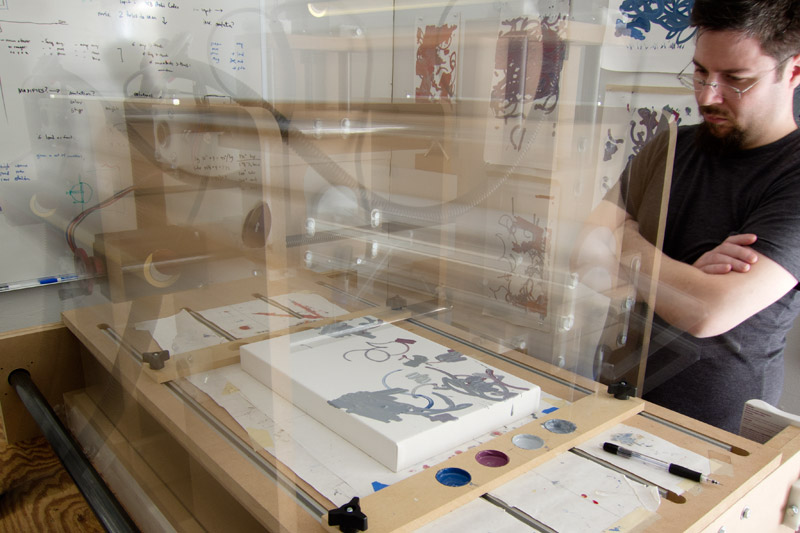
Benjamin Grosser watching his Interactive Robotic Painting Machine Make a New Painting (2011)
Please tell us about “Interactive Robotic Painting Machine”. How did you come up with this idea? and How long did you gave thought to it?
I have long been interested in the potential role of adaptive or aritificially-intelligent systems to the task of art making. As a composer, I have developed software that writes scores and/or creates sound. But as my focus switched to visual art, and specifically into investigations of technology, I started to think about how our everyday interactions are increasingly mediated by technology. These systems, such as mobile phones, search engines, or social networking sites, are designed to anticipate and support our needs and desires while facilitating those interactions. As these systems grow in complexity, or intelligence, how does that intelligence change what passes through them? Further, how does that intelligence evolve to make its own work for its own needs?
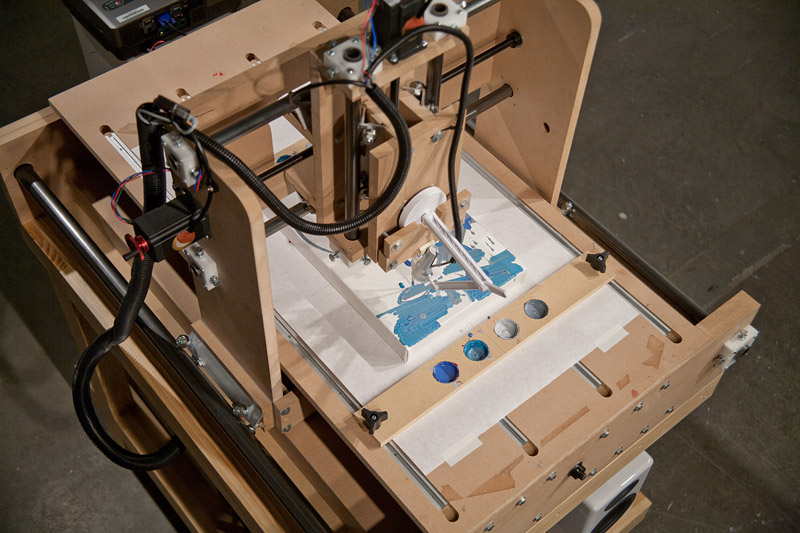
Overhead View of Interactive Robotic Painting Machine
This last question served as the launching point for my Interactive Robotic Painting Machine. Does an art-making machine of my design make work for me or for itself? How does machine vision differ from human vision, and is that difference visible in the output? Is my own consciousness reinforced by the system or does it become lost within? In other words, it this machine alive, with agency as yet another piece of the technium, or is it our own anthropomorphization of the system that makes us think about it in these ways?
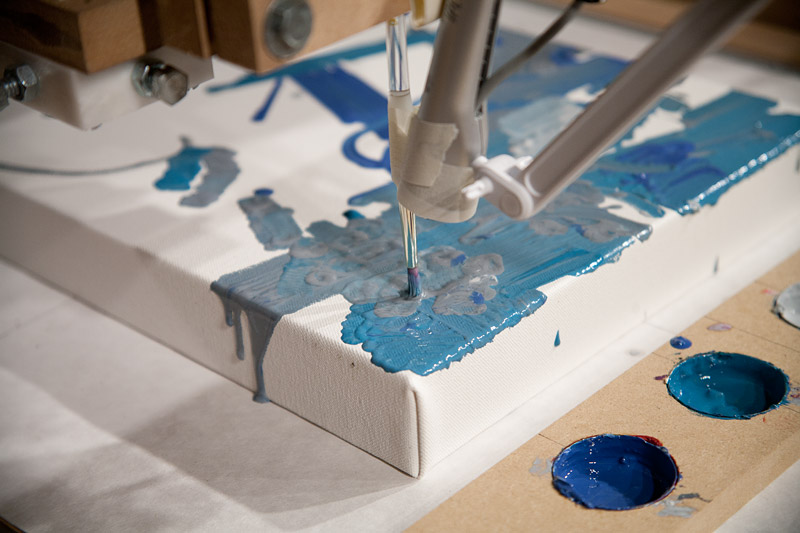
Brush Closeup of Interactive Robotic Painting Machine
What I built to consider these questions is an interactive robotic painting machine that uses artificial intelligence to paint its own body of work and to make its own decisions. While doing so, it listens to its environment and considers what it hears as input into the painting process. In the absence of someone or something else making sound in its presence, the machine, like many artists, listens to itself. But when it does hear others, it changes what it does just as we subtly (or not so subtly) are influenced by what others tell us.
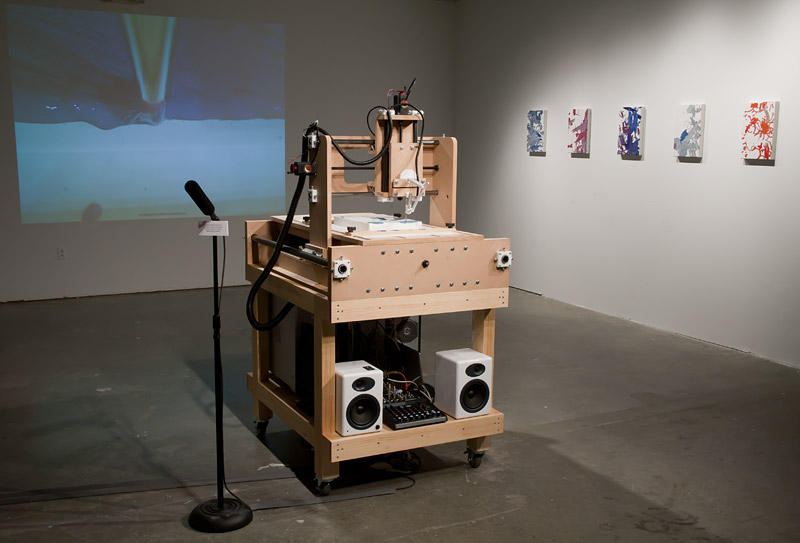
Interactive Robotic Painting Machine
I have been thinking about making the machine for many years, but once I started building and programming it, it took about 1.5 years from start to finish.
I heard that your music is“very loud and ugly”, what do you think? And how do you like to create of music?
That quote is from a newspaper review of a piece of mine titled “Epistatic Niche” for trumpet, piano, percussion and computer-generated sounds (your readers are welcome to download all my music for free if they want). I love that quote. Without question, my music uses non-tonal harmonic systems, often played in a loud, raucous style by instrumentalists, or rendered that way by the computer. For me, my music is beautiful, but others might call it ugly. That is fine with me. However, I think the more people listen to my music or other works of a similar style, the more they may start to agree with me. If they don’t, that’s okay too.
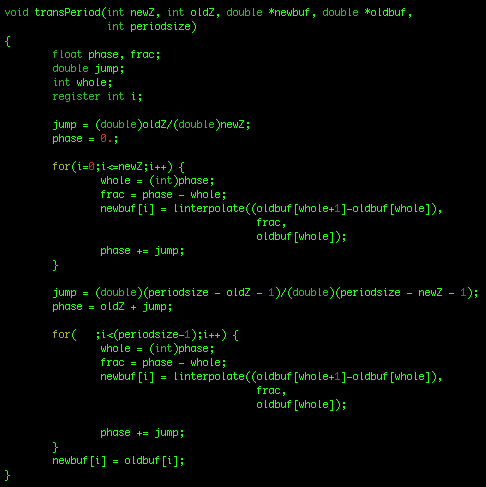
the transPeriod() function from GACSS
What are the differences between making an interactive works or making a work of music?
Interaction is about a reciprocal process between the viewer and the work. The work presents an option for interaction, the viewer performs some action that the work can understand, and the work reciprocates by reacting in a specific way to the input that was provided. This feedback loop of sorts serves as the basis of a constructed experience that hopefully helps the viewer understand the piece. Music can also have aspects of this loop, but is more about sharing a specific performed experience over a composed period of time. These differences of presentation and time scale require a different compositional process: creating interactive art requires iterative refinement of that feedback loop, while composing music is more about the creation of narrative (or an anti-narrative) from start to finish.
Who is your respectable person? Please let me know with a reason.
I am inspired by many artists and composers. Iannis Xenakis is a composer whose pioneering work combining computers and music led to some of the most “ugly” (or “beautiful” as I see it) music I’ve ever heard. I had the good fortune to study with Salvatore Martirano and Zack Browning, two more composers whose music I count amongst the most important work of the late 20th and early 21st century. As for visual artists, I like the work of Bill Viola, a video artist whose pieces make me think about time in new ways. Other artists, such as Rafael Lozano-Hemmer, Camille Utterback, Dan Graham, Roxy Paine, and Joan Mitchell have been inspirational in various ways.
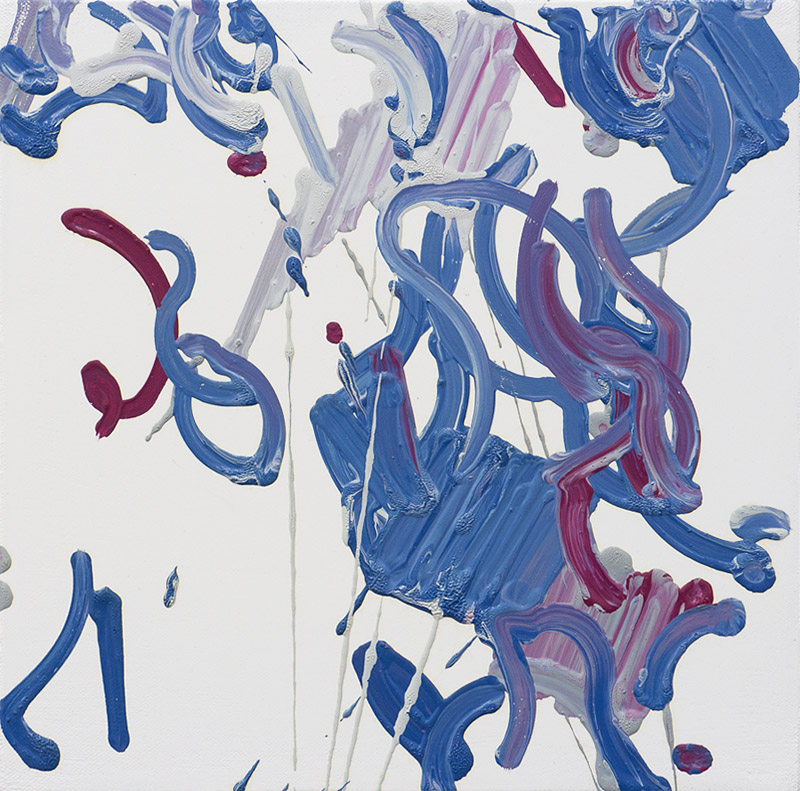
Painting Made During Head Swap (2011) / Oil on canvas, 10″x10″ / Image Credit: Interactive Robotic Painting Machine
What do you do on holidays to relax?
I read about technology and programming on the Internet, watch competitive reality TV shows, play video games, listen to music, and hang out with friends. One benefit, but perhaps also a drawback of being an artist, is that I am constantly thinking about my work because it is so fun to consider and make. So there is plenty of this going on during holidays as well.
What is exactly the technology to you. I would like to know what is your opinion bout technology. And what did you think at that time? What do technology mean to you?
Our continued creation of new technologies is one of the defining characteristics of the human species. From the wheel to the water well, from the plane to the transistor, each new technology enables new ideas and new possibilities. But every one also brings with it unexamined side effects — these are what I’m interested in. One of my favorite quotes is by the American media theorist Marshall McLuhan: “We shape our tools and thereafter our tools shape us.” Technology development moves much faster than our ability to understand all of the ways it changes our lives and and our way of life. I love it and am fascinated by it, but also can’t help but consider these other questions as well.
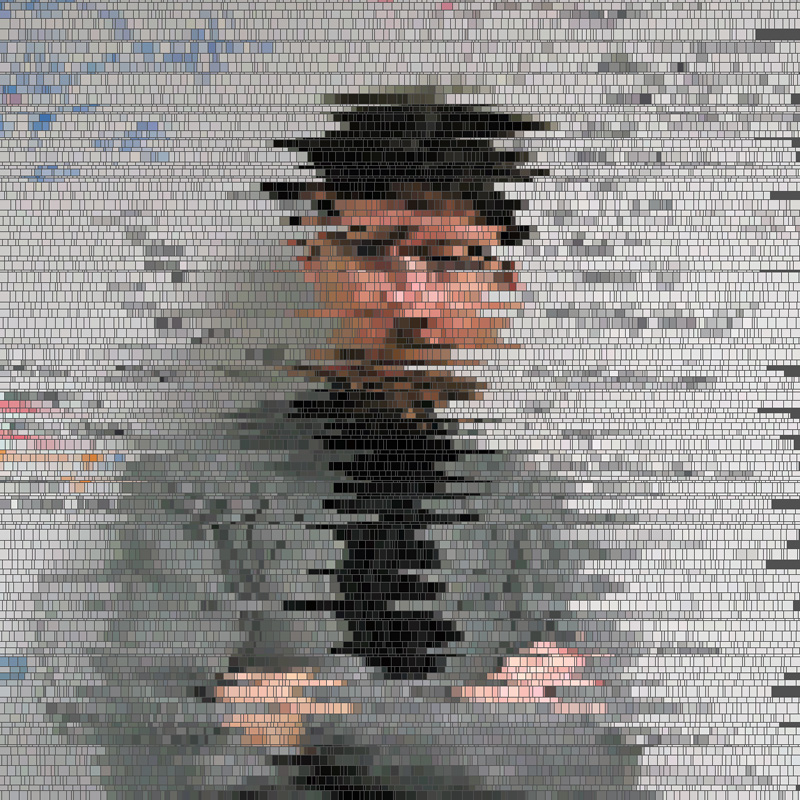
Self Portrait (2009) computationally-produced digital image using software written by the artist
What will you do your great brain to the future?
Right now I’m working on a series of interactive artworks that explore various aspects of social networks, how they homogenize identity, limit personal representation, and transform the way we relate to each other – both within and outside the network.
Thank you. We hope to seeing your works in Japan at some time!
You are very welcome, thank you for asking! I was fortunate enough to visit Japan in 2005 in order to present at the 2nd International Conference on Universal Design (in Kyoto first, then spending time in Tokyo). During that trip I fell in love with the people, the culture, and the food of Japan, and can’t wait to return. It would be an honor to show my work in Japan and I look forward to the opportunity someday soon.
Text: Memi Mizukami





